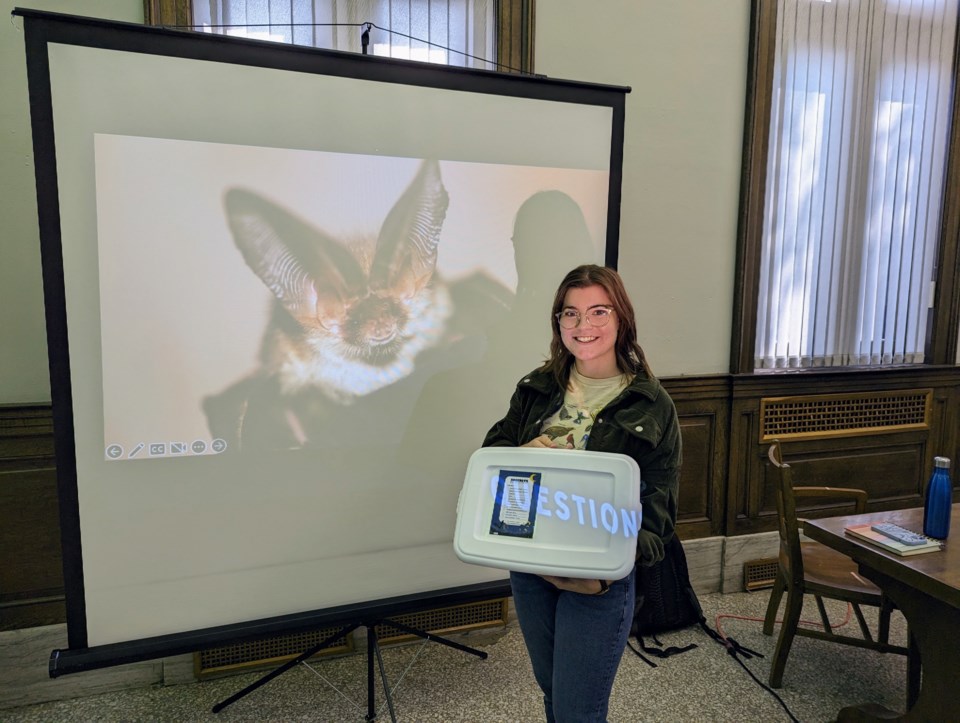Lauren MacDonald is travelling the province as part of a U of S bat conservation project, and gave two well-attended presentations at the Moose Jaw Public Library on Sept. 7, both for education on bats and to promote citizen science efforts in Saskatchewan.
"I have my undergraduate degree in biology, and a masters of science, and I'm working at the University of Saskatchewan, at the Lane Lab, as a research and outreach co-ordinator," MacDonald explained after her first session at the MJPL. "This is the very first presentation in a series, and we're bringing these bat detector kits out to various libraries across Saskatchewan.
"And we're doing a bit of a launch event like this at each stop, trying to spread awareness about the importance of bats and teach about the kits themselves. But, yeah, this is my first of about 20 to 25 that I'm doing in the next month."
MacDonald told an audience of around 30 all about bats, covering the number of species around the world, the various sizes and shapes that bats come in, and why they are important to local ecologies.
Bats are especially important in Saskatchewan because of their incredible capacity for eating insects, helping to keep populations under control. MacDonald noted that in monetary terms, bats save farmers billions of dollars per year in reduced insecticide use and increased crop productivity.
They don't just catch flying bugs, either — they'll take crickets and locusts right off the ground.
One of the bat facts MacDonald shared is the effects of White Nose Syndrome, which is rapidly spreading across North America and kills 95 to 99 per cent of colonies it infects. Three of Saskatchewan's eight bat species are hibernators and are especially affected.
"White nose fungus, which causes this syndrome, is absolutely devastating. We've never seen anything like it, and it kills very effectively," MacDonald said. "It doesn't actually kill them directly. What happens is that in our hibernating species here, it spreads during the winter and itches and irritates them so badly that they wake up, when they should still be hibernating.
"There's no food to eat, they're supposed to be sleeping so they can survive, so they use up all their fat reserves and eventually starve."
Bats are excellent flyers and can range far and wide when hunting, so the fungus, originally from Europe, has gone from Nova Scotia to Alberta in only three or four years.
Another fact is that migrating species can be quite solitary, and even the hibernators aren't always social. Bats are mammals and have complex social structures and relationships, but male bats in particular still spend a lot of time alone.
"When we think of colonies, what you're often seeing is a maternity colony of just females and pups, who have gathered to help each other raise their young," MacDonald explained.
"At the same time there's these colonies of around 100 females and pups, the males are off on their own living on a tree. They aren't necessarily shunned from the colony, but they aren't super welcomed. They prefer to be by themselves and we call them bachelor males."
Anyone can participate in bat counts by visiting BatWatch.ca and helping to record observations. At the next level, however, the bat kits from the University of Saskatchewan have ultrasonic detectors that plug into a smartphone.
Paired with an Android app (Apple is incompatible), the kits will identify and record the sounds of bat echolocation. Each species' echolocating squeaks, precise enough to pinpoint the tiniest of midges, is unique, so the detectors don't need any help.
"Citizen science can absolutely make a difference," MacDonald said. "By using community interest in bats to help us do our research, we can learn about bats across the province. I'm going to 20 towns that geographically spread out, so we get these reports of activity and species that help us focus our research and give us a lens into what's happening."
In response to some providers blocking access to Canadian news on their platforms, our website, MooseJawToday.com will continue to be your source for hyper-local Moose Jaw news. Bookmark MooseJawToday.com and sign up for our free online newsletter to read the latest local developments.




